Following up on yesterday’s post, An continues her conversation with Yancey Strickler and sums up her experience of fundraising via Kickstarter.—Ed.
An Xiao: Tell me a little more about the financial side of things. If most artists are like me, they’re not the best with keeping records and managing payments.
Yancey Strickler: We like Amazon Payments because it’s what our entire system runs on. They’re the only ones that can handle our needs. PayPal currently cannot. Plus, we’re working with the most trusted e-commerce site ever. Most people already have an Amazon account, so backing a project is like buying a book. Super simple.
The only drawback is that Amazon Payments are only set up for US customers to receive money, though anyone from other countries can give money. They’re working on expanding their services to other countries, but I don’t know when that will be changed.
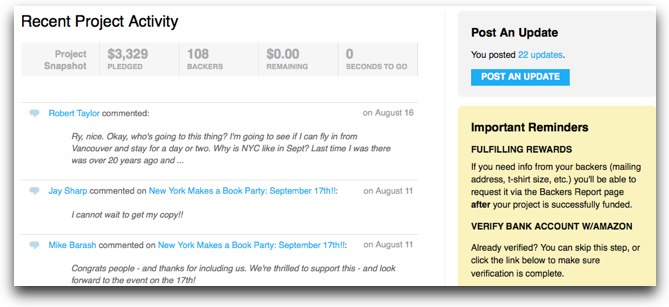
Kickstarter's super clear project dashboard, intuitive for even the most numbers-averse artist
AX: A few of my donors had issues with Amazon Payments initially, though these were quickly resolved and had nothing to do with Amazon or Kickstarter. However, one backer was never able to resolve the issue, so he opted to send me a check. How do you manage financial questions?
YS: I’m the one customer service person for Kickstarter. If anyone has any payment problems, I will end up talking to them. It’s fairly common, as you’re often putting down your credit card information three months before the card is actually charged and things happen. We work very closely with anyone who has any trouble, and there’s a full week to correct any payment problems. The number of declined or failed transactions on Kickstarter is very, very, very low.
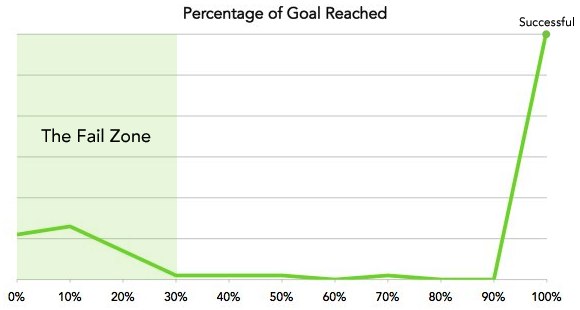
The power of momentum: if a project reaches 25% of its funding goal, it has a 90% chance of eventual success.
AX: That’s great—so artists can really focus on on the fundraising rather than the details of actually collecting the pledges.
YS: Absolutely. For a creator, it’s their job to spread the word and let people know about the project. The financials and all of that will just flow through Amazon. And best of all: creators get an email with each new pledge. It becomes this incredibly gratifying feeling—especially when it’s complete strangers doing the backing.
August 25, 2009. After a late night sending emails directly to friends and supporters, I wake up to find the needle moving, and it’s moving fast. In the Kickstarter blogs, I read that much of the fundraising is driven by momentum. It’s a slow start, but the genius of the all-or-nothing approach is that your backers have something to rally around. The emails I send are forwarded to others. Tweets are retweeted. Some backers even increase their donation, just to help move the needle.
During the day, I start looking forward to emails from Kickstarter.com, announcing a new backer. Most of them are friends, some are people I only know through the Internet, and a small few are complete strangers moved to give. By the evening, I am so close. Just barely there. My heart is racing, but it’s time to go to bed. I close my laptop and make a small wish.
AX: I see you back a good deal of projects. What is the motivation behind backing projects? Why do backers give to creative projects?
YS: I think I’ve backed the most projects of anyone. I look at every project on the site. I watch every video and look through everything.
I’ll often feel charmed, and I see the sincerity of what someone is doing. If I see a reward that I like the idea of having and it costs less than $15, I’ll probably get it. A little while ago I had one week when I literally got something in the mail each day. Rob Blagojevich magnets. Postcards. T-shirts. All handmade and very very very cool.
AX: I want to see the Blagojevich magnets.
YS: I’m thinking that at some point I want to have boxes of only things I got on Kickstarter. I eventually want a wardrobe of only clothes purchased on Kickstarter. Speaking for myself (and I think this is fairly true for other people), I want a reward that’s cool. Something I can hang on my wall. Something with a story behind it. Something the artist put effort into. I’m willing to spend money on that.
If there’s a video or presentation, and I can see the person and believe in them, I can’t pull out my wallet fast enough.
AX: Too bad you guys don’t have an office—it could be fully decorated with Kickstarter rewards.
YS: There will hopefully be an office in the next six weeks. When we do get it, it needs to be decorated by Kickstarter rewards. We’ll make sure that happens.
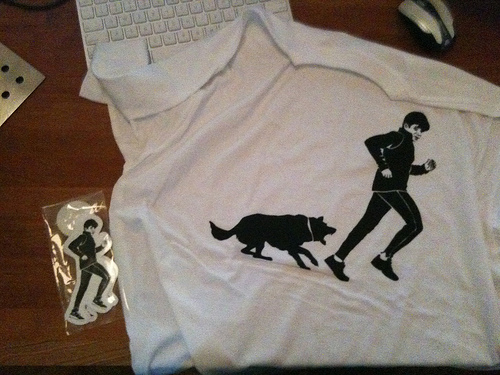
One of Yancey's rewards, for supporting the Run, Blago, Run Kickstarter project
AX: There are so many artists and creative types out there looking for funding. How do you plan to manage the site as it grows?
YS: We are going to have this invite system going for a while longer. Since the start, the quality of projects coming our way is really, really high. I’m constantly amazed at the people who find us and the conversations I have. I email with every single person who comes in. We often talk in-depth about their idea and what they want to do.
It is invite-only, but we’re not making judgments on aesthetics. I’m talking to people to find out how sincere they are. I make sure that what they’re doing fits under our umbrella of creative and ambitious. I want to talk to them about what they’re doing and see if they’re sincere about what they’re pursuing.
Over time, there are going to be more and more and more projects. The way the site works now, with everyone tapping into their networks, allows it to continue to grow without becoming competitive. Everyone is rooting for each other. They understand and look around and support each other. Maintaining that tone will be very important.
AX: And challenging.
YS: I’m positive we’ll be able to maintain that. It’s an attitude in how we treat people and talk to people. I’m a founder of the company, and I do customer service six hours a day. It’s probably the most important thing I do. I’m talking directly with people and helping with problems.
We also learn from our creators. I’m constantly seeing people push Kickstarter farther than we expected. I learned more from Allison Weiss than I ever thought I could learn. Another great example is Robin Sloan, of Robin Writes a Book. It’s amazing what he’s doing. His project is like a graduate studies class on what you can do on Kickstarter, and this is just our fifth month.
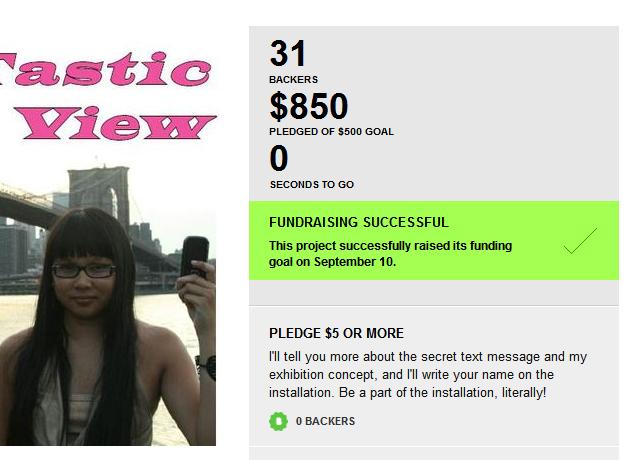
A vibrant green greets the successful project at the end
August 26, 2009. I wake up to find I’ve not just hit my $500 goal, but blown past it. I’ve reached the tipping point, and I find my eyes tearing up slightly by the support. A dream of mine for four years, to put together a weird art installation on the Brooklyn waterfront, is actually within grasp, and the extra funds even allow me to be a little more ambitious with the materials.
It doesn’t matter how successful they are, or how many accolades they’ve collected—I don’t know a single artist who doesn’t feel their confidence waver whenever they put together a new piece. It’s incredibly moving to receive financial backing from dozens of individuals who don’t just believe in me but are willing to give a little to support my creative vision.
Over the next few weeks, even though I’ve already reached my goal, more backers will continue to give. It’s a stunning experience.
AX: Speaking of success, it looks to me like y’all have had an excellent launch. What’s your ultimate vision for Kickstarter?
YS: That’s a big question. Right now I think we’re happy to watch it grow and evolve with our members.
One certainty is that Kickstarter will be proven to work up and down the food chain. It works just fine for that guy in his garage making something for $500. I’ve seen it work for people doing something for $20,000.
It can work just as well for Quentin Tarantino or Radiohead or Julian Schnabel or whoever. If Quentin Tarantino snaps his fingers, he can raise $20 million in Hollywood, but what percentage of the finished film is actually his that he owns? Less than 10%, certainly.
When you come through Kickstarter, you keep complete ownership and control. It’s just a matter of time before established artists start to see that and use it. David Lynch has been a dream project from the beginning. The day that happens will be a good one. That’s the sort of person I could see using Kickstarter. It would be great to have a site where David Lynch is raising money alongside some kid making his first movie who idolizes him. That would be awesome.
AX: It would take the director’s cut to the next level.
The potential of Kickstarter is profound. In the traditional funding model, artists from time immemorial have had to rely on a small group of generous patrons and institutions giving large sums of money to commission work and support their living, especially at the beginning of their careers. Kickstarter bypasses this model and democratizes it. Instead of raising large amounts from a few, artists can now raise small amounts from the many. It also generates a sense of community, as artists cheer on other artists and give to each other’s projects in a supportive and creative environment.
It really is only a matter of time until an Obama-like artist, through the power of charisma, a compelling message and broad social network, crowdsources the funds for a major arts project, something on the scale of Olafur Eliasson’s Waterfalls and Christo and Jeanne-Claude’s The Gates.
AX: So I’m ending with perhaps the most important question for Art21 readers: how do you start?
YS: You should think about what you want to do. Something specific, and something you feel passionate about. Think about what rewards backers should get. Figure out how to tell your story and how to spread the word. Then send an email to [email protected]. That email goes directly to me, and we’ll talk about it.
AX: Thanks, Yancey, for sitting down to chat.
***
If you’re an artist interested in getting started, be sure to get in touch with Yancey. I found him to be incredibly passionate about Kickstarter and the artists on the site. He provides excellent customer service with a generous spirit. It strikes me as vital that Kickstarter continue to develop and grow this community, even as it continues to grow in size.
And if you’re interested in dipping your toes into arts patronage, check out the Kickstarter Recommended page, or back some of my favorite fine arts projects currently raising funds:
- Art Supplies for Indigo Youth Movement in South Africa—Steel artist Miya Ando’s great work for a great cause. A winning formula.
- A Dictionary Story—Lovely book project by Sam Winston
- Facebook Portraits—Support Matt Held’s quest to paint 200 portraits based solely on Facebook photos
- Emoji Dick—A fascinating and bizarre push by Fred Benenson to translate Moby Dick into Japanese emoji
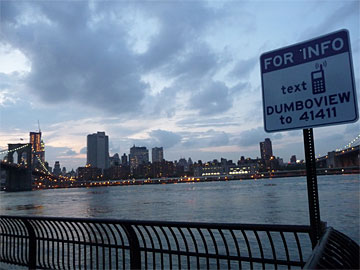
The completed sign
After successfully raising $850 via Kickstarter, I’m excited to share that I was able to upgrade my installation from a 5 foot pole and small street sign, to a 30” square sign that stands 8 feet tall and lights up at night for all to see. The installation goes live tonight at the 13th Annual D.U.M.B.O. Art Under the Bridge Festival from Sept. 25 to Sept. 27. The festival is the largest urban forum of its kind for experimental art in the United States and celebrates art that is touchable, accessible, and interactive.
A special thanks to Textmarks.com for donating their texting service for the weekend; SignsDirect for consulting on my sign project; and Joe Zuccarini, BJ Watkins and Pete Powlison for assisting with installation. And of course, the biggest thanks to my 31 backers, Ranjit Bhatnagar, Sarah Covert, Nikki Farquhar, Jeffrey Hanson, Juakali, Bill Pangburn, Pete at Newcurator.com, Joanie San Chirico, Laurie Schorr, smArts & Culture, Juliet Vedral, Glenn Waggner and Lisa Waggner, and a number who wish to remain anonymous, who generously gave to this project. This was very much a community effort from Tokyo to New York to London, from start to finish.
Artist An Xiao looks at the Internet and the 21st century using a creative approach that is one part visual/conceptual and one part Zen. Recently listed in The Guardian’s “who’s who” of the Twitter art world, she has shown her award-winning photography and digital media in publications and galleries internationally, including the Brooklyn Museum, Yale/Haskins Laboratories, The New York Times and ARTNews. She founded and directs @Platea, a global online public art collective.



Pingback: Kickstarting Creative Projects: An Innovative Micro-Giving Site, Part 1 of 2 | Art21 Blog